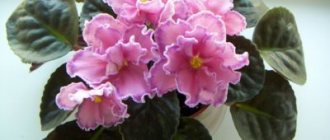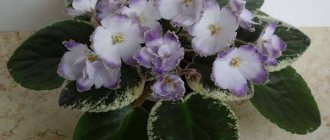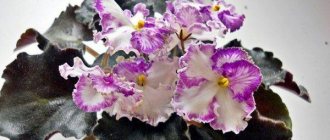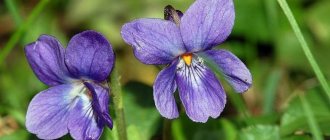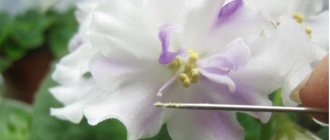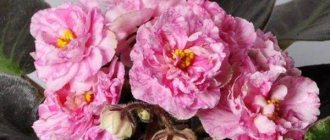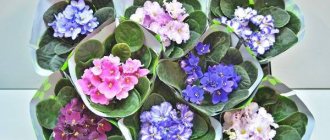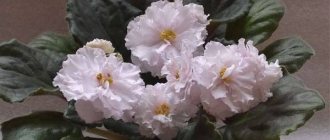Violet is an evergreen indoor flower , and the variety of varieties captivated us with their amazing shapes and colors.
Red, blue, pink and even green – amazing and delicate flowers can fill your home with bright colors all year round. Violets are unpretentious, but not many people manage to achieve such lush flowering. And all because each variety of Uzambara violet has distinctive nuances in care.
Tatyana Pugacheva and her flowers
Kursk breeder Tatyana Pugacheva is known not only in Russia, but throughout the entire post-Soviet space. A wonderful woman, an excellent florist, made her hobby her life’s work. It is thanks to the efforts and labors of T. Pugacheva that the collections of many flower lovers are replenished with new specimens. Original author's varieties are sold both on the Internet, on a collector's website, and at various flower exhibitions.
Tatyana Pugacheva is a famous collector involved in the selection of new varieties . Her achievements have been recognized at various international exhibitions. She not only brings the fruits of her labor, but also actively communicates with flower lovers, helping them understand how to care for their pets.
Today you can read about Tatyana’s work with flowers not only on her website. The collector's work was noted by flower lovers. New, newly bred varieties are actively discussed on forums for indoor plant lovers.
Breeders were able to develop a large number of species of violets. Read our articles with descriptions of Saintpaulia varieties with the names of the people who grew them:
- Tatiana Dadoyan;
- Natalya Skornyakova;
- Korshunova Elena;
- Natalya Puminova;
- K. Morev;
- Svetlana Repkina;
- Elena Lebetskaya;
- Evgenia Arkhipova.
Recommendations for planting and care
The great advantage of Lebetskaya violets is their unpretentiousness in flower care. If the bush is grown correctly, problems may not arise at all.
What type of soil does he like, lighting, degree of moisture, planting container?
Violet Summer Twilight - description and characteristics of the variety
To properly grow violets, it is necessary to create favorable conditions indoors, as well as plant the flower in nutritious soil. The optimal temperature for keeping is 20-26 ℃. You should beware of drafts, as the plant does not respond well to temperature fluctuations.
For maintenance, it is necessary to select places with diffused light so that the plant does not get burned. With a lack of light, flowering will not be abundant. The soil is regularly fed with mineral fertilizers. To do this, use superphosphate and carry out the procedure twice a month.
Water the bush once a week so as not to flood it, otherwise the soil will compact and become unusable. After watering, the soil is loosened to a depth of 3-4 centimeters.
Important! To grow, you need to select neutral soil; in acidic soil, the flowers of the bush will begin to dry out and turn pale.
The main difficulties in caring for a plant
There are no serious difficulties in growing. The main thing is not to flood the bush and monitor the lighting. When water stagnates in the soil, pests and infectious diseases can appear.
The most popular varieties
There are no unbeautiful flowers! Many flower lovers will agree with this statement. But, every breeder has varieties that are especially loved by plant fans. Among the varieties bred by Tatyana Pugacheva there are some that can be distinguished.
PT "Tsarskaya Osoba"
The variety is distinguished by a neat, dense rosette. The flowers are large, purple-burgundy in color with a white wavy border along the edges. The variety can be either simple or semi-double. Flowers look extremely elegant and will decorate any apartment .
PT "Larissa"
Violet is distinguished by very large two-color flowers. Senoplia is white in color, has a lilac core and a yellow eye. The bush blooms very profusely and has a neat rosette of dark green leaves.
PT “Purple Flicker”
The leaves are medium green and form a neat rosette. The bush blooms with a large cap . On medium-double flowers, you can see transitions from light lilac to dark lilac; you can also observe nude tones on some flowers.
PT "Infinity"
The variety was released in 2016 and immediately became a favorite at exhibitions. A neat rosette is formed by light green terry leaves. Flowers are distinguished by their originality. They can be found both simple and semi-double. The main color is white, along the edges you can see a light green border of varying thickness. In the middle of the flower there is a pink core. It can range from dark pink to light pink.
Description of Wittrock violet
This is a perennial of complex hybrid origin, created with the participation of tricolor violet (V. tricolor), Altai violet (V. altaica), yellow violet (V. lutea) and horned violet (V. cornuta). A highly branching plant with a compact or semi-spreading form, 15–40 cm high.
The leaves are alternate, petiolate, with crenate edges, ovoid or oval in shape below and narrow at the top of the shoot. The flowers are large, 4 to 12 cm in diameter, solitary, formed in the axils of the leaves.
The corolla is 5-petalled, of various colors, from pure white to coal-black, monochromatic or with streaks and spots of various colors and sizes.
As you can see in the photo, the petals of the Wittrock violet can be smooth, corrugated or with wavy edges:
Flowering begins at the end of April and continues throughout the warm season.
Prefers nutritious, moist and loose soils, sunny or semi-shaded places. It can be cultivated as an annual, biennial or perennial crop. Extremely widely used in landscaping around the world as a garden, flower bed, container, potted plant.
This page provides a description of Wittrock's viola varieties from different garden groups.
A few secrets of good flowering from breeders
- Place. In order for a flower to delight with a riot of colors, it must be placed in a warm place. Saintpaulia is extremely sensitive to temperature. Therefore, in order for a flower to bloom and please the eye, you need to choose a cozy, warm place for it.
- Lighting. Lighting also affects the abundance of flowering and the brightness of flowers. Violets bloom regardless of the time of year. Therefore, in winter, in order for the bushes to have as many flower stalks as possible, they need to be given more daylight. To do this, special lamps will come to the rescue; they can be bought at any flower shop.
- Watering mode. Water is life.
Violets, like many other plants, love water. Therefore, in order for them to bloom well and please their owners, be sure to water the flowers. It is necessary that the soil is slightly moist. But, you need to observe moderation. Otherwise, you can “flood” the plant and excess water will only harm it. When a violet blooms, it consumes more water and the soil dries out much faster. Therefore, it is extremely important to be especially attentive to watering during this period of the bush’s life. - Wet air. An air humidifier is one of the main friends of indoor plants. Violets are no exception. To prevent young buds from drying out, you need to purchase a humidifier and use it constantly. This becomes especially true in the winter months, when central heating radiators greatly dry out the air in the room.
- Feeding and fertilizers. Flowering takes a lot of the plant's strength. Therefore, after the flower has faded, it needs to be helped to restore its strength. Otherwise, it will not bloom soon, and there will hardly be many or bright flowers. Modern mineral fertilizers are ideal for feeding. Depending on the concentration of fertilizer, flowers can be fed either once a month or with each watering. The phosphorus contained in the mixtures will strengthen the horse system and the bush will delight its owners with abundant flowering.
Features of reproduction
The method of propagation by leaf cuttings (rooting in water) is often used. The leaves are cut from the mother plant, rooted (from 2 weeks to 1 month), covered with a bag. Carry out careful drip irrigation. After rooting, replant.
Additional Information! Using a similar scheme, leaf cuttings are rooted in a substrate (perlite and soil mixture 3:1). The method is suitable for not very high-quality planting material.
When propagating violets, the planting procedure is carried out when shoots with a diameter of up to 5 cm appear at the base of the cuttings. If it is not possible to purchase a ready-made substrate, prepare the soil for planting yourself. To do this, mix peat, river sand, leaf debris, perlite or special moss in equal proportions.
Varieties that deserve special attention: description and photo
Each breeder’s collections have their own “stars” . These are not only plants that have gained popular popularity. As a rule, these are specimens noted at various exhibitions.
Tatyana Pugacheva, along with her pets, is a welcome guest at such events. She is invited to all major exhibitions and festivals of indoor plants held in Russia, Ukraine and European countries. Some varieties brought by the collector are rightfully considered the favorites of such events.
Next you can see photos of violets bred by Tatyana Pugacheva.
"Natalie"
The Natalie variety belongs to the Uzabar violet. Family - Gesneriaceae, belongs to the genus Saintpaulia hybrida. A distinctive feature of the variety is very large semi-double pink flowers with a white border. There is a white fantasy pattern on the petals .
The variety is distinguished by its rosette. The leaves of the flower are dark green, the underside of the leaf is bright red. Foliage may rise to the top. The flower is a half-bell, with a brightly colored center and a light, and sometimes white, border.
On one branch you can find flowers of different brightness and shape. Terry growth is not immediately apparent, not until the second or even third flowering. For normal growth and flowering, the variety needs good lighting, gives a lot of sports, and sometimes you can find a chimeric color.
"Elenika"
The Elenka variety is distinguished by a soft white semi-double color of large size, the edge is corrugated. Some specimens have a green border. Depending on the temperature and lighting conditions, the brightness of the border may be brighter or paler. Sometimes it is completely absent, this does not mean that the flower is sick or is not comfortable. Perhaps it will appear in the next bloom. Terry growth can be observed starting from 2-4 flowerings .
The socket is neat and medium in size. The leaves are medium green in color, both outside and on the underside. Flowering is abundant, bouquet, long lasting.
"Dance of the Reeds"
Violet variety Dance of the Reeds is characterized by simplicity and elegance . Unusual in their shape, regular and semi-double flowers look great on a bush. The flowers are light pink, blending into each other. The edges of the petals can be colored purple, green and white. Flowering is long-lasting and bouquet. Neat rosette, two-color leaves.
"Jacqueline"
This variety of violet can be recognized by its large, densely double pom-pom flowers. The petals are bright pink, decorated with a red-purple border and a bluish fantasy. The approximate size of one flower is 5 centimeters. Flowering is cap-shaped, abundant, flowers open unevenly and slowly.
The rosette is neat, the violet grows quite quickly. Growth is positively affected by warmth and daylight. Flowering lasts just over a month .
Retro varieties of violets
According to an unspoken rule, all varieties of foreign selection obtained in the last century are completely conditionally classified as retro varieties.
IMPORTANT! Domestic varietal violets are classified as retro if they were bred before 1990. Starting from this border, for inexplicable reasons, violets acquire a decorative appearance and a modern perception that differs from retro varieties.
In the Soviet Union, Saintpaulia first appeared in Leningrad - in the Botanical Garden associated with the State University. The first specimens of violets were brought there and its director D.M. Zalessky . The breeding developments of this specialist include the magnificent varieties “Blue Danube” and “Light and Shadow”.
Boris Mikhailovich Makuni , who devoted forty years of his life to delicate violets and created more than 300 of their varieties, is unconditionally recognized as a luminary in the domestic selection of Saintpaulia In order not to divide the breeding line of the Makuni spouses (Boris Mikhailovich worked on varieties together with his wife Tatyana Nikolaevna), who created new Saintpaulias until 2002, all their varieties are considered a retro category.
Boris and Tatyana Makuni.
At the same time as the Master, many domestic breeding enthusiasts worked on the decorative appearance of violets. All of their varieties, created from the late 60s to 19990 and preserved in the collections of flower growers, belong to retro violets.
The reasons for this name
In Soviet times, only passionate non-professional flower growers . They did not know how to keep records and describe the varieties obtained, and did not think about creating catalogs and classifiers.
In this regard , many developments disappeared without a trace, and varieties were preserved in minimal quantities . It is for this reason that their violets are classified as retro.
ATTENTION! In addition, all antiques, household items and decorations that rarely appear in everyday life and carry some historical or material value fall under the term “retro”. This category also includes violet varieties bred from the last century.
Distinctive features of plants bred by Tatyana Pugacheva
The products presented by Tatyana Pugacheva at exhibitions and in online stores are always of the highest quality. Flower collectors and simply plant lovers can easily recognize the pets of this breeder.
As a rule, all offered specimens have large and sometimes simply huge fluffy flowers. The predominant color scheme is pink, you can also find fuchsia, purple and fantasy, white are often present. Almost all violets are two, three, and sometimes even four colors.
Almost all flowers have a neat small rosette . Flowering type: bouquet. Over time, during the third or fourth flowering period, you will notice that the petals acquire a more intense color. Also, the color scheme and growth are affected by lighting, timely subcortex and an abundance of daytime color.
Top varieties of domestic and foreign selection
Domestic selection
In the second half of the 20th century, a whole galaxy of passionate flower growers and self-taught breeders worked on the creation of new varieties of Saintpaulia.
Their names are unknown to a wide circle of violet lovers, but without their dedicated work, the emergence of new modern varieties of this marvelous plant would be difficult. Among them are:
- D.M. Zalessky;
- Makuni spouses;
- V.N. Kolesova;
- S.A. Aksyonova;
- L.V. Radin;
- V.A. Mikheeva;
- I.D. Lowbrow;
- S.I. Prilutskaya and many, many others.
“Beloved Daughter” (B.M. Makuni)
Saintpaulia type standard . Above a dense rosette of slightly wavy leaf blades of a dark green shade, a cloud of lavender color is formed from large corollas of simple fullness.
The petals have a wavy outline outlined in dark purple.
The peculiarity of the violet is the lightening of the color of its flowers as they open.
“Sweetie” (B.M. Makuni)
“Sweetie” is a representative of the Pink Series. Violet standard type.
The rosette with a neat outline consists of leathery, slightly long leaves of a dark tone with a marsh tint. The edge of the sheet is wavy, the reverse side is illuminated in red.
Flowering is cap, almost all year round. The corollas are pink carnations with a greenish fringe on each petal.
“Lilac Fog” (B.M. Makuni)
Standard type. Violet leaves of a dark shade with a rounded-toothed edge form a symmetrical rosette of dense fullness.
The voluminous cap is formed from wavy-corrugated terry-type corollas, colored with transitions of different tones of lilac.
The peculiarity is a very long period of preparation for flowering.
“Solveig’s Song” (B.M. Makuni)
"Solveig's Song" represents the author's Blue Series, being the best in the line . Standard.
An evenly filled, compact rosette is formed by rounded leaves the color of summer grass. Strong flower stalks support magnificent large corollas of a semi-double appearance with a wave along the edges of the petals.
Coloring - shimmering blue tones.
“Blue Danube” (D.M. Zalessky)
One of the first varieties of domestic selection. Standard type.
The neat rosette consists of rounded-toothed leaves with wavy edges, painted in the tone of dark green with an emerald vein. Corollas of simple fullness with a slightly wavy outline.
The buds are painted in a delicate tone of bluish-lilac color.
“Orchid” (V.A. Mikheev)
Based on the type of flower color, Saintpaulia is classified as a two-color violet.
The leaves are greenish-marsh in color with lighter veining and have a rounded shape with a slight point.
The simple-looking corollas are painted with shimmering lilac colors. Along the contour of the flower there is a white edging, turning into a clear pattern on the upper petals.
“Mazepa” (L.V. Radina)
The violet has a somewhat loose rosette due to the elongated leaf petioles. The leaf blades are rounded and light green in color.
The corollas are large in size, terry full.
The peculiarity of the violet is the change in the color of the bud : from a marble pattern in white and lilac tones to a dark lilac color.
“Dark Cherry Shawl” (I.D. Low-bow)
Standard type variety. The rosette is formed dense, with a symmetrical contour .
The leaves have a quilted structure, dark green color and a round configuration with a slight nose.
Flowering in a cap form. The corollas are laid in large sizes, with increased terry, a juicy shade of ripe cherries.
“Miss Moscow” (I.D. Nizkous)
Saintpaulia standard type . With a compact structure, an even rosette of dark green color is assembled from rounded leaf plates with a quilted structure on elongated petioles.
Flowering occurs with the formation of large corollas of terry fullness with waviness at the ends of the petals. The buds are painted with an intense shade of thick pink , reaching a ruby color.
“Rose in the Dust” (S.I. Prilutskaya)
Violet standard type. The medium-sized rosette consists of small-diameter, rounded, wavy-toothed leaf plates the color of lush grass.
It blooms with large terry-type corollas , each petal of which bends in waves. The coloring is distinguished by gentle transitions from white to shades of lilac of varying intensity.
Foreign selection
Flower growers in European countries and America began their developments much earlier than Soviet specialists; the history of their selection is rich in successful discoveries and solutions.
In these countries, entire schools of violet breeding have been established, where they learned in time to classify and describe new varieties.
Good to know! This made it possible to preserve retro violets in a larger volume, indicating the authors and year of creation.
White Madonna (J. Eyerdom) 1953
“White Madonna” was for a long time almost the only variety of violet in the USSR .
An even standard rosette, wavy-jagged leaves of a dark tone, large, terry-type snow-white corollas.
Delft Imperial (J. Eyerdom) – 1962
A classic of breeding developments, a standard type variety.
Symmetrical rosette, dark green leaves with a sharp-toothed edge on light petioles, deep blue corollas with terry fullness .
Neptune (Armacost & Royston) – 1935
Standard with oval-pointed leaves of a lush green color and strong veining. The flowers are simple in appearance , painted in a delicate lilac color with a transition to a thicker shade closer to the center.
The variety is not far removed from natural species.
French Lilac (J. Swift) – 1976
Large standard. The leaves are dark in color with sharp teeth along the edge.
The corollas are terry type, lilac-bell-shaped in color with a lighter edge along the contour of the petals.
Lilian Jarrett (F. Tinari) – 1961
Rounded leaf plates with a pointed end, the color of lush green.
It blooms with double-type corollas in delicate shades of pink.
